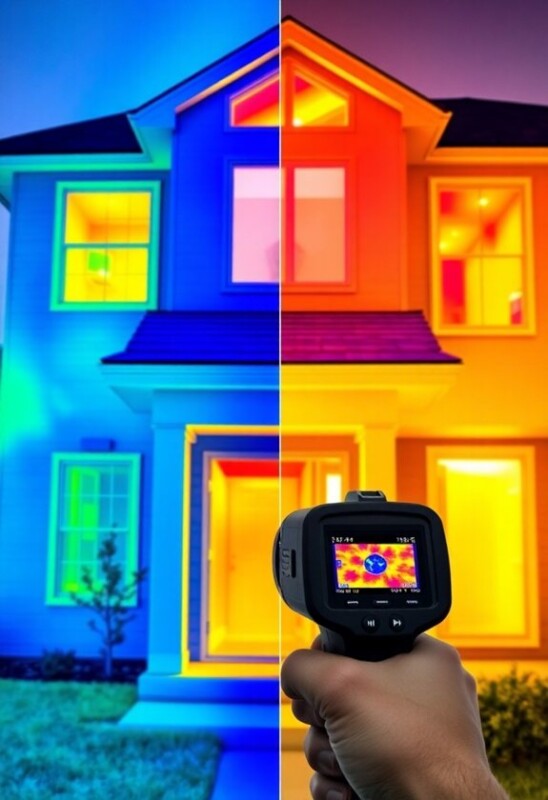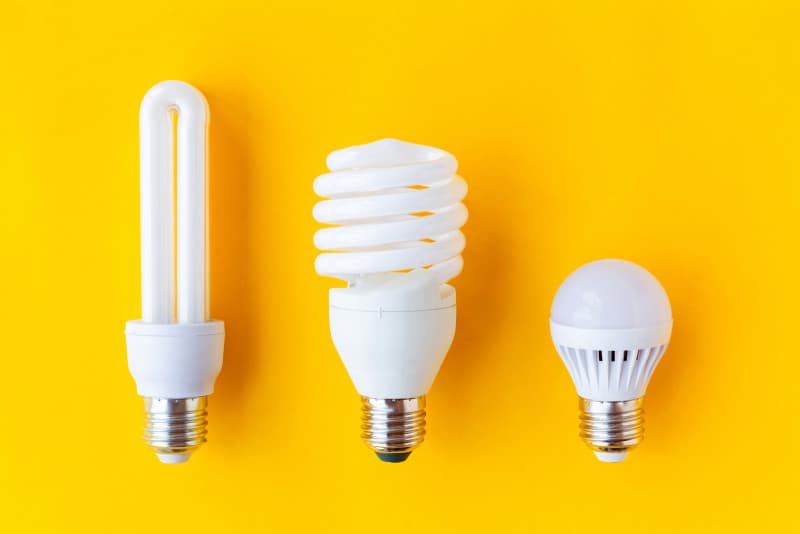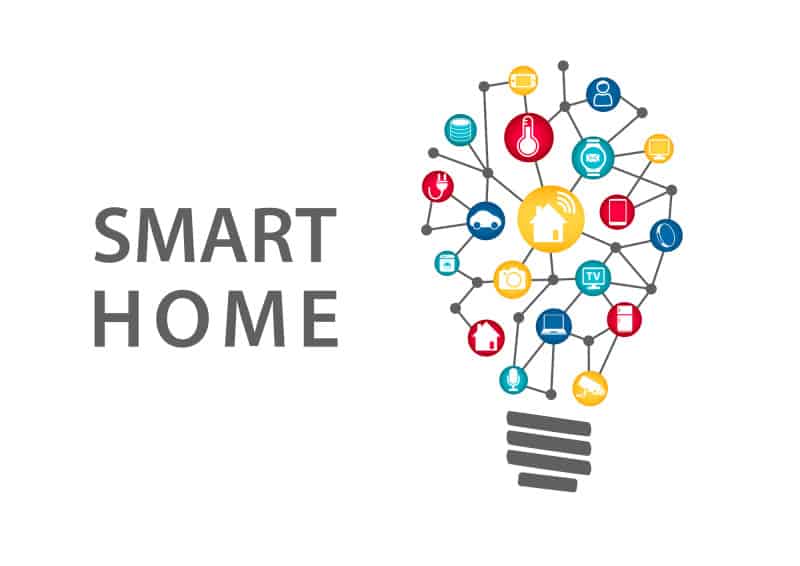Your home’s energy savings potential likely exceeds what you’d expect, with most houses wasting 25-30% on air leaks alone. You’ll find significant losses through standby electronics (75% of consumption), inefficient HVAC systems (20-25%), and outdated windows (15-20%). By implementing strategic upgrades from LED lighting to smart thermostats, you can cut annual costs by $1,500 or more. Our thorough analysis reveals exactly where your biggest saving opportunities lie.
Key Takeaways
- Hidden energy waste from standby electronics, air leaks, and inefficient HVAC systems can cost homeowners up to $1,200 annually.
- Basic energy upgrades like LED lighting, weatherization, and unplugging devices can reduce energy consumption by 30%.
- Smart home technologies and programmable thermostats can optimize energy usage and qualify for up to $1,500 in rebates.
- Solar panel installations offer 13.52% ROI and can save homeowners approximately $37,500 over 25 years.
- Energy efficiency scoring systems help identify improvement areas, with lower HERS® Index scores indicating better performance.
The Hidden Cost of Energy Waste in Your Home
While many homeowners focus on their monthly utility bills, the true cost of household energy waste often lurks in unexpected places.
Your standby electronics alone can account for 75% of total energy consumption, with Wi-Fi routers wasting 102 kWh annually and plasma TVs consuming 145 kWh in standby mode.
Professional energy audits can reveal these hidden drains, from inefficient HVAC systems losing 20-30% through poor insulation to refrigerators wasting 7% through frequent door openings.
Simple behavioral changes, like unplugging devices and maintaining air filters, can markedly reduce these invisible costs and optimize your home’s energy efficiency.
Smart Upgrades That Pay for Themselves
Smart home upgrades deliver substantial returns through incentive programs that dramatically reduce initial investments.
You’ll find up to $1,500 in TVA EnergyRight rebates for HVAC upgrades, water heaters, and air sealing improvements. These incentives, combined with available tax credits, make energy efficient appliances more accessible and cost-effective.
Through the Quality Contractor Network, you can access $0 down financing while certified professionals handle both installation and rebate paperwork.
Smart thermostat benefits extend beyond convenience, offering precise climate control and reduced energy consumption. When paired with proper insulation and HVAC tune-ups, these upgrades create a thorough energy-saving solution that pays for itself.
Breaking Down Your Home’s Energy Loss Points
Five key areas account for most residential energy loss, with outdated homes experiencing up to 40% waste through poorly sealed entry points and insufficient insulation. Your home’s efficiency depends on addressing air infiltration impact, insulation effectiveness, and HVAC efficiency in critical zones.
| Loss Point | Waste % | Annual Cost |
|---|---|---|
| Air Leaks | 25-30% | $200-400 |
| HVAC Use | 20-25% | $300-500 |
| Windows | 15-20% | $150-300 |
You’ll enhance energy savings by targeting these areas systematically. Start with sealing gaps around windows and doors, then address insulation gaps in walls and attics. Consider your appliance energy loss – older models can waste up to 30% more energy than modern equivalents.
Solar Investment: By the Numbers
Investing in solar technology delivers measurable financial rewards, with U.S. homeowners averaging $1,500 in annual savings and $37,500 over a 25-year system lifespan.
Solar panel benefits extend beyond utility savings. You’ll gain a 13.52% ROI, outperforming S&P 500 stocks, while adding $15,000 to your home’s resale value.
With systems costing $10,290-$20,580, financial incentives like the 30% federal tax credit reduce your initial investment to around $12,600. You’ll reach payback in 6-8 years, then enjoy decades of reduced energy bills.
Modern panels achieve 15-22.8% efficiency, cutting utility costs by 20-50% through net metering programs.
Window Solutions for Maximum Savings
While homeowners often overlook window efficiency, upgrading your windows represents one of the most impactful energy-saving investments you can make.
With 25-30% of heating and cooling loss occurring through windows, choosing the right window types is essential. Triple-pane designs with Low-E coatings and argon gas deliver superior performance over standard models.
Modern insulation materials like vinyl and fiberglass frames, combined with SuperSpacer technology, can reduce your energy bills by up to 34%.
You’ll recoup about 69% of costs through increased home value, while ENERGY STAR-certified windows save $126-$465 annually compared to single-pane alternatives.
Insulation Secrets: Where Heat Escapes Most
Understanding where heat escapes in your home reveals a critical pattern: exterior walls account for 35% of heat loss, while attics, windows, and basements each contribute 25%, 25%, and 15% respectively.
You’ll enhance energy efficiency by targeting these major escape routes with strategic solutions:
- Add attic insulation to reach 11+ inches for fiberglass or 8+ inches for cellulose
- Address thermal bridging through wall retrofitting with blown-in materials
- Seal air leaks around fixtures, pipes, and foundation penetrations
Energy audits help identify specific weak points, while proper moisture management protects your insulation investment.
Consider window upgrades and crawl space sealing to complete your home’s thermal envelope.
Regional Factors Affecting Your Energy Bill
Because your location plays a decisive role in energy costs, regional factors can create substantial variations in household energy bills. Regional climate patterns, available energy sources, and policy impacts directly affect your costs. You’ll face higher bills in southeastern states due to intense AC needs, while rural energy users often rely on propane or wood heating.
| Region Type | Primary Energy Challenges | Cost Impact Factors |
|---|---|---|
| Southeast | Heavy AC demand, electric heat | Higher consumption |
| Rural Areas | Limited grid access, propane use | Fuel volatility |
| Urban Centers | Grid dependency | Policy regulations |
| Natural Gas States | Resource abundance | Lower costs |
| Renewable Mandate States | Grid instability | Higher rates |
Understanding these regional variations helps you assess your household efficiency potential and identify targeted solutions for your specific location.
Calculating Your Home’s Energy Efficiency Score
To accurately measure your home’s energy performance, several standardized scoring systems provide detailed assessments based on source energy consumption and regional factors.
Your energy score calculation depends on certified raters using efficiency rating methods like HERS® Index, ENERGY STAR, or Home Energy Score systems.
Key factors affecting your score include:
- Home size and type (larger homes typically score lower)
- Local climate data from weather stations
- Equipment efficiency (HVAC systems, insulation, windows)
These standardized metrics help you understand where you stand, with lower scores indicating better performance.
HERS® Index targets 70 or below, while ENERGY STAR aims for 75+ to identify top performers.
Modern Tech Vs Traditional Energy Solutions
While measuring your home’s efficiency score provides valuable baseline data, the choice between modern technology and traditional energy solutions shapes your path to improved performance. Smart technology offers superior energy adaptability through AI-driven optimization, while traditional systems remain less flexible and more resource-intensive.
| Feature | Modern | Traditional |
|---|---|---|
| Initial Cost | Higher | Lower |
| Operating Cost | Lower | Higher |
| Energy Efficiency | >50% savings | Baseline |
| Adaptability | AI-optimized | Manual |
| Environmental Impact | Reduced emissions | Higher emissions |
You’ll find the most significant impact in heating/cooling, where smart systems can dramatically reduce the 50% energy consumption typical of traditional setups through predictive analytics and demand response capabilities.
Mapping Your 5-Year Energy Savings Plan
Creating an effective 5-year energy savings plan requires systematic mapping of your home’s efficiency potential and a clear implementation timeline.
Start with goal setting by analyzing your current energy consumption and establishing realistic reduction targets of 10-30%. Energy audits will reveal your home’s specific inefficiencies and guide your upgrade priorities.
- Year 1-2: Implement low-cost solutions like weatherstripping and LED lighting
- Year 3-4: Invest in mid-range upgrades such as smart thermostats and insulation
- Year 5: Execute major improvements including heat pumps and window replacements
Track your progress monthly using utility data and smart meters, adjusting your strategy based on verified savings and emerging technologies.
Conclusion
Your home’s energy efficiency path doesn’t end with a single upgrade. By tracking your energy score, implementing smart technologies, and addressing key loss points, you’ll see 25-40% savings within five years. Calculate your potential ROI using regional data and energy audits, then prioritize improvements based on payback periods. Modern solutions like solar panels combined with traditional upgrades create the most cost-effective path to energy optimization.



